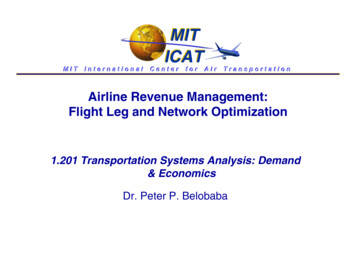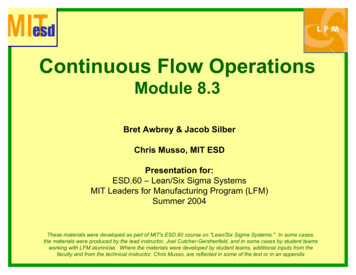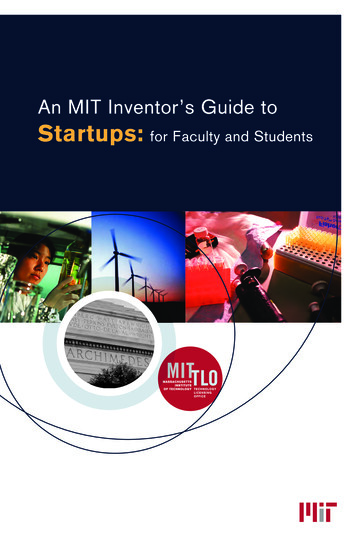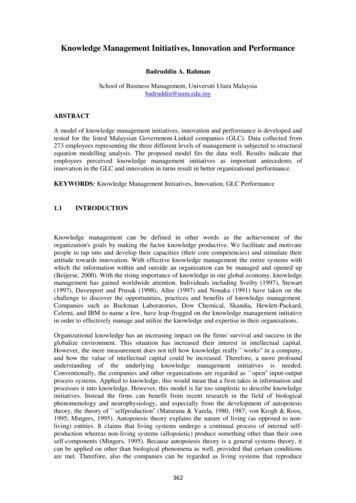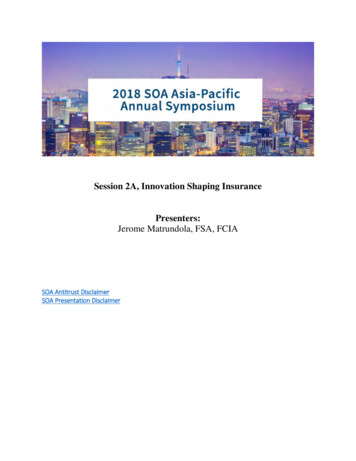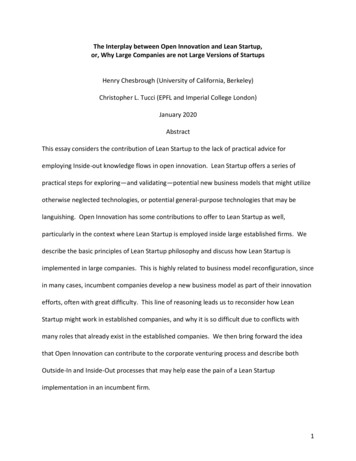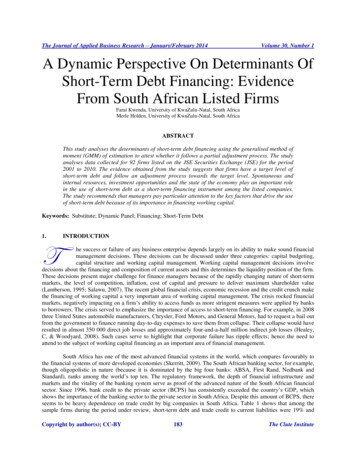
Transcription
THE SOURCESOF INNOVATION
THE SOURCESOF INNOVATIONEric von HippelNew YorkOxfordOxford University Press1988
Oxford University PressOxford New York TorontoDelhi Bombay Calcutta Madras KarachiPetaling Jaya Singapore Hong Kong TokyoNairobi Dar es Salaam Cape TownMelbourne Aucklandand associated companies inBeirutCopyrightBerlinIbadan Nicosia1988 by Eric von HippelPublished by Oxford University Press, Inc.,200 Madison Avenue, New York, New York 10016Oxford is a registered trademark of Oxford University PressAll rights reserved. No part of this publication may be reproduced,stored in a retrieval system, or transmitted, in any form or by any means,electronic, mechanical, photocopying, recording, or otherwise,without the prior permission of Oxford University Press.Library of Congress Cataloging-in-Publication DataHippel, Eric von.The sources of innovation.Includes index.1. Technological innovations-Economic aspects.I. Title.HC79.T4H56 1988 338'.06 86-28620ISBN 0-19-504085-6Figures 2.1 and 2.2 are reprinted from Eric von Hippel,"The Dominant Role of Users in the Scientific Instrument Innovation Process,"Research Policy, July 1976, Vol. 5, No. 3.8 10 9Printed in the United States of Americaon acid-free paper
Dedicatedto:ARvHDvHJRJ
ACKNOWLEDGEMENTSThe research reported on in this book spans a period of twelve years. In thattime I have been helped by many colleagues, students, innovators, and research sponsors. I have striven to make the research and this book worthy ofthe generous help I have been given.I would like to thank Thomas Allen, Anne Carter, Zvi Griliches, Ken-ichiImai, Ralph Katz, Edwin Mansfield, Richard Nelson, Ikujiro Nonaka, ArielPakes, Richard Rosenbloom, and Roy Rothwell for giving me many valuablecomments as the research proceeded.I have been fortunate to have had a number of very talented visiting scholars and graduate students join me in research and discussion over the years.Especially prominent among these are: John Becker, Alan Berger, JulianBoyden, Alan Drane, Abbie Griffin, David Israel-Rosen, Andrew Juhasz,Toshihiro Kanai, Susumu Kurokawa, Walter Lehmann, Howard Levine, William Lionetta, Gordon Low, Richard Orr, Barbara Poggiali, KiyonoriSakakibara, Stephen Schrader, Frank Spital, Heidi Sykes-Gomez, PieterVanderWerf, and Walter Yorsz. All contributed greatly to the substance ofthe work and to the sheer fun of research.Over the years my students and I have interviewed hundreds of people.Some were the developers of the important innovations we studied, whileothers had less direct knowledge. Many loaned us materials and all strove tohelp us to accurately understand their industries and their innovation-relatedexperiences. Thanks to all.The research I report on here would not have been possible without fundingfrom the Division of Policy Research and Analysis of the National ScienceFoundation. Alden Bean, Miles Boylan, Andrew Pettifor, Rolf Piekharz,Eleanor Thomas, and anonymous peer reviewers supported my work over theyears with a series of grants, despite budgets for extramural research thatsometimes dropped perilously near zero.Finally, I would like to thank Jessie Janjigian, who edited my manuscript andtried, with partial success, to teach me that respectable sentences can be lessthan a paragraph long, and that they need not include dashes-for emphasis.Cambridge, MassachusettsOctober 1987EvH
CONTENTS1 Overview3The Functional Source of InnovationVariations in the Source of InnovationAn Economic ExplanationUnderstanding the Distributed Innovation Process:Know-how Trading Between RivalsManaging the Distributed Innovation Process: Predicting andShifting the Sources of InnovationImplications for Innovation ResearchImplications for Innovation ManagementImplications for Innovation Policy345567892 Users as Innovators11The Sources of Scientific Instrument InnovationsThe Sources of Semiconductor and Printed Circuit BoardAssembly Process InnovationsThe User-Dominated Innovation Process1119253 Variations in the Functional Source of Innovation28Users as Innovators: PultrusionManufacturers as Innovators: The Tractor ShovelManufacturers as Innovators: Engineering ThermoplasticsManufacturers as Innovators: Plastics AdditivesSuppliers as InnovatorsSupplier/Manufacturers as Innovators:Wire Termination EquipmentSuppliers as Innovators: Process Equipment UtilizingIndustrial Gases and ThermoplasticsAdditional Evidence on Nonmanufacturer Innovation2830323435363840
xContents4 The Functional Source of Innovation as an EconomicPhenomenon43The HypothesisNecessary PreconditionsPatents and LicensingTrade Secrets and Licensing434447545 Testing the Relationship Between the Functional Sourceof Innovation and Expected Innovation Rents57Five Empirical TestsPultrusion Process Machinery: Innovation and Innovation RentsThe Tractor Shovel: Innovation and Innovation RentsEngineering Plastics: Innovation and Innovation RentsProcess Equipment Utilizing Industrial Gases and Thermoplastics:Innovation and Innovation RentsConclusions and Discussion6 Cooperation Between Rivals: The Informal Tradingof Technical Know-how57606366687076Informal Know-how TradingCase Study: Informal Trading of Proprietary Process Know-howBetween U.S. Steel Minimill ProducersAn Economic Explanation for Know-how TradingInformal Know-how Trading in ContextDiscussion767 Shifting the Functional Source of Innovation93Nature of the TestThe TestCommercial Value of User-Developed InnovationsSummary93959699778588908 Predicting the Source of Innovation: Lead Users102Root of the Problem: Marketing Research Constrained byUser ExperienceLead Users as a SolutionTesting the MethodDiscussion1021061081159 Epilogue: Applications for Innovation Management117Identifying an Innovation Process RoleOrganizing for an Innovation Process RoleThe Distributed Innovation Process as a System117118120
ContentsxiReferences12Appendix: Innovation Histories131IntroductionData Set forData Set forData Set forData Set forData Set forData Set for131133163182188195199IndexScientific Instrument- InnovationsSemiconductor Process InnovationsPultrusion Process Machinery Innovationsthe Tractor ShovelEngineering PlasticsPlastics Additives3209
1OverviewIt has long been assumed that product innovations are typically developed byproduct manufacturers. Because this assumption deals with the basic matterof who the innovator is, it has inevitably had a major impact on innovationrelated research, on firms' management of research and development, and ongovernment innovation policy . However, it now appears that this basic assumption is often wrong.In this book I begin by presenting a series of studies showing that thesources of innovation vary greatly. In some fields, innovation users developmost innovations. In others, suppliers of innovation-related components andmaterials are the typical sources of innovation. In still other fields, conventional wisdom holds and product manufacturers are indeed the typical innovators. Next, I explore why this variation in the functional sources of innovationoccurs and how it might be predicted. Finally, I propose and test some implications of replacing a manufacturer-as-innovator assumption with a view of theinnovation process as predictably distributed across users, manufacturers,suppliers, and others.The Functional Source of InnovationMost of the studies in this book use a variable that I call the functional sourceof innovation. This involves categorizing firms and individuals in terms of thefunctional relationship through which they derive benefit from a given product, process, or service innovation. Do they benefit from using it? They areusers. Do they benefit from manufacturing it? They are manufacturers. Dothey benefit from supplying components or materials necessary to build or usethe innovation? They are suppliers. Thus, airline firms are users of aircraftbecause the benefit they derive from existing types of aircraft-and the benefit they would expect to derive from innovative aircraft as well-are derivedfrom use. In contrast, aircraft manufacturers benefit from selling aircraft, and3
The Sources of Innovation4TABLE 1-1.Summary of Functional Source of Innovation DataInnovation Developed byInnovation TypeSampledScientific instrumentsSemiconductor and printedcircuit board processPultrusion processTractor shovel-relatedEngineering plasticsPlastics additivesIndustrial gas-usingThermoplastics-usingWire termination 0400249101651612142000000333656120000870aNA number of cases for which data item coded in this table is not available. (NA cases excluded fromcalculations of percentages in table.)they would expect to benefit from an innovative airplane product by increasing their sales and/or profits.Of course, the functional role of an individual or firm is not fixed; it depends instead on the particular innovation being examined. Boeing is a manufacturer of aircraft, but it is also a user of machine tools. If we were examininginnovations in aircraft, we would consider Boeing to have the functional roleof manufacturer in that context. But if we were considering innovations inmetal-forming machinery, that same firm would be categorized as a user.Many functional relationships can exist between innovator and innovationin addition to user, supplier, and manufacturer. For example, firms and individuals can benefit from innovations as innovation distributors, insurers, andso forth. As we will see later in this book, any functional class is a potentialsource of innovation under appropriate conditions.Variations in the Source of InnovationNovel ways of categorizing innovators are only interesting if they open theway to new insight. The first clue that the functional source of innovation is apotentially exciting way to categorize innovators comes with the discoverythat the source of innovation differs very significantly between categories ofinnovation. Consider the several categories of innovation my students and Ihave studied in detail over the past several years (Table 1-1). In each studysummarized in Table 1-1 the innovator is defined as the individual or firmthat first develops an innovation to a useful state, as proven by documented,useful output.Note the really striking variations in the functional source of innovationbetween the several innovation categories studied. Major product innovations
Overview5in some fields, such as scientific instruments, are almost always developed byproduct users. In sharp contrast, product manufacturers are the developers ofmost of the important innovations in some other fields, and suppliers in stillothers (chapters 2 and 3).An Economic ExplanationThe observation that the functional source of innovation can vary is interesting in itself. But if we can understand the cause(s) of such variation, we maybe able to predict and manage the innovation process much better.There are many factors that influence the functional source of innovation.But we need not necessarily understand all of these in order to understand thisvariable usefully well and to predict the sources of innovation usefully often.As the reader will see, I propose that analysis of the temporary profits ("economic rents") expected by potential innovators can by itself allow us to predict the functional source of innovation usefully often (chapter 4).This basic idea will certainly not be a surprise to economists. If it is to beuseful in this context, however, certain preconditions must be met,* andexpectations of innovation-related profits must differ significantly betweenfirms holding different functional relationships to a given innovation opportunity. Since little is known about how firms formulate their expectations ofprofit from innovation, I have explored this matter in several detailed caseinvestigations (chapter 5).In all cases studied, it did appear that innovating firms could reasonablyanticipate higher profits than noninnovating firms. The reasons for such differences varied from industry to industry. Interesting hints of general underlyingprinciples did emerge, however, and sometimes these were related to thefunctional relationship between innovator and innovation. For example, usersoften had an advantage over other types of potential innovator with respect toprotecting process equipment innovations from imitators. (Users often canprofit from such an innovation while keeping it hidden behind their factorywalls as a trade secret. This option is seldom available to manufacturers andothers, who typically must reveal an innovation to potential adopters if theyhope to profit from it.)Understanding the Distributed Innovation Process:Know-how Trading Between RivalsOnce we understand in a general way why the functional sources of innovation may vary, we can graduate to exploring the phenomenon in greater*I discuss and test conditions later; two, however, may convey the flavor. For an economicmodel of the functional source of innovation to predict accurately, it is necessary that potentialinnovators (1) not be able to shift functional roles easily and (2) benefit from their innovations byexploiting them themselves rather than by licensing them to others.
6The Sources of Innovationdetail. Are there general strategies and rules that underlie how expectationsof economic rents are formed and distributed across users, manufacturers,suppliers, and others? If so, we may gain a more general ability to predict howinnovations will be distributed among these several functional categories offirm.It is not clear a priori that useful rules for generating or predicting innovation strategies will exist: Such strategies are themselves a form of innovation,and one may not be able to describe the possibilities in terms of underlyingcomponents or rules. The only way to find out, I think, is by field investigation. I have undertaken one such investigation to date and have found aninteresting phenomenon-informal know-how trading-that seems to me tohave the characteristics of a generally applicable component for innovationstrategies (chapter 6).Informal know-how trading is essentially a pattern of informal cooperativeR & D. It involves routine and informal trading of proprietary informationbetween engineers working at different firms-sometimes direct rivals.(Know-how is the accumulated practical skill or expertise that allows one todo something smoothly and efficiently, in this instance the know-how of engineers who develop a firm's products and develop and operate its processes.Firms often consider a significant portion of such know-how proprietary andprotect it as a trade secret.) Know-how trading exists in a number of industriesmy students and I have studied, and it seems to me to be an importantphenomenon.When I model informal know-how trading in terms of its effects oninnovation-related profits, I find that one can predict when this behavior willor will not increase the expected profits of innovating firms. I propose thatknow-how trading between rivals is a general and significant mechanism thatinnovators can use to share (or avoid sharing) innovation-related costs andprofits with rivals. As such, it is one of the tools we can develop and explore aswe seek to understand the distributed innovation process.Managing the Distributed Innovation Process:Predicting and Shifting the Sources of InnovationEven though our understanding of the distributed innovation process is at anearly stage, we should be able to get managerially useful results from it now.Indeed, it would be risky to not subject this work to the discipline of realworld experiment and learning by doing.Since I have argued that variations in the sources of innovation are causedto a significant degree by variations in potential innovators' expectations ofinnovation-related profits, two managerially useful things should be possible.First, by understanding how expected innovation profits are distributed, wemay be able to predict the likely source of innovation. Second, by changingthe distribution of such profit expectations, we may be able to shift the likelysource of innovation. If both of these fundamental things can be done, we
Overview7would be well along the way to learning how to manage a distributed innovation process.My colleague Glen Urban and I worked together to test the possibility ofpredicting the sources of a subset of user innovations: those having the potential to become commercially successful products in the general marketplace.(Not all user innovations have this characteristic. A user will innovate if it seesan in-house benefit from doing so and typically does not consider whetherother users have similar needs. In contrast, a manufacturer typically requiresthat many users have similar needs if it is to succeed in the marketplace with aresponsive product.)The particular context of our test (chapter 8) was the rapidly evolving fieldof computer-aided-design equipment used to lay out printed circuit boards(PC-CAD).' Here we found that we could identify a subset of users that wetermed lead users. We found innovation activity concentrated within thisgroup as predicted: 87% of respondents in the lead user group built their ownPC-CAD system versus only 1% of nonlead users. We also found that productconcepts based on these lead user innovations were preferred by all users andtherefore had commercial promise from the point of view of PC-CAD productmanufacturers. This result suggests, by example, that prediction of sources ofcommercially promising innovation may be possible under practical, realworld conditions.My colleague Stan Finkelstein and I tested the possibility of shifting thesource of innovation in the field of automated clinical chemistry analyzerequipment (chapter 7).2 Differences in clinical chemistry analyzer productdesigns were found that made some analyzer brands more expensive for innovating users to modify than others. If innovating users were seeking to maximize innovation benefit, we hypothesized that there should be more userinnovation activity focused on the economical-to-modify analyzers-for experiments requiring equipment modification.We tested this hypothesis in several ways and found it to be supported. Weconcluded that managers may sometimes be able to shift the sources of innovation affecting products of interest to them by manipulating variables undertheir control, such as product design.Implications for Innovation ResearchWhen a model fits reality well, data fall easily and naturally into the patternspredicted. I have been repeatedly struck by the clear, strong patterns that canbe observed in the data that my students and I have collected on the functional sources of innovation. I hope that this aspect of the findings will notescape the eye of researchers potentially interested in exploring the functionally distributed innovation process.Can we use the strong patterns identified in the functional sources of innovation to build a better understanding of the way innovation-related profits arecaptured? It seems to me to be important to do so: The nature and effective-
8The Sources of Innovationness of strategies for capturing innovation-related profits probably have asgreat an impact on economic behavior as do considerations of transactioncosts or economies of scale, yet we know much less about them.As an example of a strong pattern in the functional source of innovationdata worth exploring, consider that my hypothesis simply states that innovations will be developed by those who expect a return they find attractive. Butthe data show that innovations of a specific type are typically developed byfirms that expect the most attractive return. Can we build from this to showthat those expecting the most attractive returns in an innovation category willinvest more and eventually drive out all others over time? If so, we will greatlyimprove our ability to understand and predict the sources of innovation on thebasis of innovation-related profits.As an example of how a better understanding of real-world patterns ininnovation-related profits may help us understand a range of economic issues,consider the matter of why firms specialize. Current explanations of thisphenomenon focus on consideration of maximizing economy in production.But in the instance of process equipment, decisions by users to develop theirown equipment do not appear to me to be motivated by such make-or-buysavings. Instead, innovating users appear to be motivated by considerations ofincreased profits they may obtain by having better equipment than that available to competitors. That is, they seem to be motivated primarily by considerations of innovation-related rents.The research my students and I have carried out to date has primarilyfocused on product and process categories in which innovator firms havedeveloped innovations on their own and have had only a single functional rolewith respect to those innovations. (An innovator was typically a user or amanufacturer, but not both.) The world clearly has more complex cases in it.In some fields of innovation, firms may customarily join with others to develop innovations cooperatively. In other fields firms may typically be vertically integrated or for some other reason contain multiple functional roleswithin the same organization. These more complex patterns should be studied. Possibly, but not certainly, we will be able to understand them in terms ofthe same principles found operating in simpler cases.In the hope that some colleagues will find further research on the functionalsources of innovation intriguing, I provide case materials (appendix). Thesemay serve some as a convenient source of initial data.Implications for Innovation ManagementInnovation managers will, I think, find much of practical use in the research Iexplore in this book. The fact that the sources of innovation can differ hasmajor consequences for innovation managers, both with respect to the organization of R & D and marketing and to management tools (chapter 9).Firms organize and staff their innovation-related activities based on theirassumptions regarding the sources of innovation. Currently, I find that most
Overview9firms organize around the conventional assumption that new products are-orshould be-developed by the firm that will manufacture them for commercialsale. This leads manufacturers to form R & D departments capable of fulfillingthe entire job of new product development in-house and to organize marketresearch departments designed to search for needs instead of innovations.Indeed, if a manufacturer depends on in-house development of innovationsfor its new products, then such arrangements can serve well. But if users,suppliers, or others are the typical sources of innovation prototypes that afirm may wish to analyze and possibly develop, then these same arrangementscan be dysfunctional. (For example, one cannot expect a firm's R & D groupto be interested in user prototypes if its engineers have been trained andmotivated to undertake the entire product development themselves.) Oncethe actual source of innovation is understood, the nature of needed modifications to firms' related organizational arrangements can be addressed.New sources of innovation demand new management tools as well as neworganization. Marketing research methods traditionally used to seek out andanalyze user needs must be modified if they are to be effective for seeking outprototype products users may have developed. Similarly, tools for analyzingand possibly shifting the functional sources of innovation are not in firms'current management inventory and must be developed.Early versions of needed tools will be found in this book. Obviously, muchmore work must be done. But I urge that innovative managers not wait forbetter tools and experiment now. Where patterns in the functional sources ofinnovation are strong, managers with a good understanding of their industriescan get useful results by combining the basic concepts presented in this bookwith their own rich insights-and they should not be reluctant to do this.Implications for Innovation PolicyPolicymakers will find this research on the distributed innovation processinteresting for many of the same reasons that managers will: Attempts todirect or enhance innovation must be based on an accurate understanding ofthe sources of innovation.As was the case for innovation managers, government policymakers neednew tools to measure and perhaps influence a functionally distributed innovation process, and these have not yet been developed. Pending the development of such tools, however, much can be done simply through an understanding that the innovation process can be a functionally distributed one.As an illustration, consider the current concern of U.S. policymakers thatthe products of U.S. semiconductor process equipment firms are falling behind the leading edge. The conventional assessment of this problem is thatthese firms should somehow be strengthened and helped to innovate so thatU.S. semiconductor equipment users (makers of semiconductors) will not alsofall behind. But investigation shows (Table 1-1) that most process equipmentinnovations in this field are, in fact, developed by equipment users. There-
10The Sources of Innovationfore, the causality is probably reversed: U.S. equipment builders are fallingbehind because the U.S. user community they deal with is falling behind. Ifthis is so, the policy prescription should change: Perhaps U.S. equipmentbuilders can best be helped by helping U.S. equipment users to innovate atthe leading edge once more (chapter 9).The elements in the example I have just described can clearly be seen ascomponents in a distributed innovation process that interact in a systemlikemanner. Eventually, I hope we will understand such systems well enough tohave a ready taxonomy of moves, countermoves, and stable states. But evenour present understanding of the functionally distributed innovation processcan, in my view, help us to advance innovation research, practice, and policymaking.Notes1. Glen L. Urban and Eric von Hippel, "Lead User Analyses for the Developmentof New Industrial Products" (MIT Sloan School of Management Working Paper No.1797-86) (Cambridge, Mass., June 1986), and ManagementScience (forthcoming).2. Eric von Hippel and Stan N. Finkelstein, "Analysis of Innovation in AutomatedClinical Chemistry Analyzers," Science & Public Policy 6, no. 1 (February 1979): 2437.
2Users as InnovatorsIn this chapter I begin by exploring who actually develops novel, commerciallysuccessful scientific instruments. Then I explore the actual sources of innovation in two major classes of process equipment used by the electronics industry.In both of these areas, I find that the innovators are most often users.The discovery that users are innovators in at least some important categories of innovation propels us into the first major question I examine in thisbook: Who actually develops the vast array of new products, process equipment, and services introduced into the marketplace? The answer is clearlyimportant: An accurate understanding of the source of innovation is fundamental to both innovation research and innovation management.The Sources of Scientific Instrument InnovationsScientific instruments are tools used by scientists and others to collect andanalyze data. My study of scientific instrument innovations focuses on fourimportant instrument types: the gas chromatograph, the nuclear magneticresonance spectrometer, the ultraviolet spectrophotometer, and the transmission electron microscope. Each of these instrument types was, and is, veryimportant to science.l**The gas chromatograph was a revolutionary improvement over previous wet chemistry methods used to identify chemical unknowns. Analyses that formerly took years to do or that could notbe done at all prior to the innovation could now often be done in hours with gas chromatography.The nuclear magnetic resonance spectrometer (lately applied to medical research but initiallyused by chemists) opened an entirely new approach-the analysis of nuclear magnetic momentsto the determination of molecular structures. The ultraviolet spectrometer made analysis ofmaterials by means of their ultraviolet spectra (a very useful research tool) easily achievable. Thetransmission electron microscope allowed researchers for the first time to create images of objectsdown to a resolution unit of approximately one angstrom (A), far better than could be achievedby any optical microscope.11
12The Sources of InnovationTABLE 2-1.Scientific Instrument Sample CompositionImprovementsInstrument TypeGas chromatographNuclear magnetic resonance spectrometerUltraviolet absorption spectrophotometerTransmission electron 451400(63121567844463111My innovation sample for each of the four instrument families included theinitial, first-of-type device as it was first commercialized and the many commercially successful major and minor "improvement" innovations that enhanced the performance of that basic device over the succeeding 20 or moreyears.The sample structure, shown in Table 2-1, might initially seem rather odd.Why focus on the innovations that improved just four types of scientificinstrument? After all, many types of scientific instrument exist 2 and perhapsthe generalizability of results might be better served by a random samplingfrom the whole field? Focusing on a few instrument types in depth, however,offers several advantages.First, by examining successive innovations affecting a given instrumenttype, variables such as the nature of the market and industry structure, whichmight affect the sources of innovation we observe, can be controlled for.Second, a sample that follows the evolution of a few products over 20 or moreyears allows us a longitudinal view o
innovation process as predictably distributed across users, manufacturers, suppliers, and others. The Functional Source of Innovation Most of the studies in this book use a variable that I call the functional source of innovation. This in




